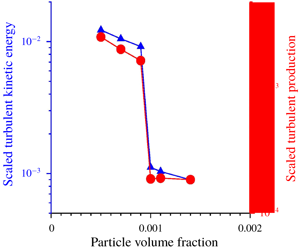Article contents
Disruption of turbulence due to particle loading in a dilute gas–particle suspension
Published online by Cambridge University Press: 26 February 2020
Abstract

The modification of fluid turbulence due to suspended particles is analysed using direct numerical simulations for the fluid turbulence and discrete particle simulations where the point-particle approximation is used for the particle force on the fluid. Two values of the Reynolds number based on the channel width  $h$ and the average gas velocity
$h$ and the average gas velocity  $\bar{u}$,
$\bar{u}$,  $(\unicode[STIX]{x1D70C}_{f}\bar{u}h/\unicode[STIX]{x1D702}_{f})=3300$ and 5600 are considered, where
$(\unicode[STIX]{x1D70C}_{f}\bar{u}h/\unicode[STIX]{x1D702}_{f})=3300$ and 5600 are considered, where  $\unicode[STIX]{x1D70C}_{f}$ and
$\unicode[STIX]{x1D70C}_{f}$ and  $\unicode[STIX]{x1D702}_{f}$ are the gas density and viscosity. The particle Reynolds number based on the root mean square of the difference in the particle and fluid velocities is in the range 4–15. The particle volume fraction is small, in the range
$\unicode[STIX]{x1D702}_{f}$ are the gas density and viscosity. The particle Reynolds number based on the root mean square of the difference in the particle and fluid velocities is in the range 4–15. The particle volume fraction is small, in the range  $0{-}3.5\times 10^{-3}$, the mass loading is varied in the range 0–13.5 and the particle Stokes number (ratio of particle relaxation time and fluid integral time) is varied in the range 1–420. Multiple models for the force on the particles are examined, the Stokes drag law, the Schiller–Naumann correlation, a correction to determine the ‘undisturbed’ fluid velocity at the particle centre, the lift force and wall corrections. In all cases, as the particle volume fraction is systematically increased, there is a discontinuous decrease in the turbulence intensities at a critical volume fraction. The mean square velocities and the rate of production of turbulent energy decrease by 1–2 orders of magnitude when the volume fraction is increased by
$0{-}3.5\times 10^{-3}$, the mass loading is varied in the range 0–13.5 and the particle Stokes number (ratio of particle relaxation time and fluid integral time) is varied in the range 1–420. Multiple models for the force on the particles are examined, the Stokes drag law, the Schiller–Naumann correlation, a correction to determine the ‘undisturbed’ fluid velocity at the particle centre, the lift force and wall corrections. In all cases, as the particle volume fraction is systematically increased, there is a discontinuous decrease in the turbulence intensities at a critical volume fraction. The mean square velocities and the rate of production of turbulent energy decrease by 1–2 orders of magnitude when the volume fraction is increased by  $10^{-4}$ at the critical volume fraction. There is no compensatory increase in the particle fluctuating velocities or the energy dissipation rate due to the drag force on the particles, and there is a significant decrease in the total fluid energy dissipation rate at the critical volume fraction. This shows that the turbulence collapse is due to a catastrophic reduction in the turbulent energy production rate. This is contrary to the current understanding that turbulence attenuation is caused by the enhanced dissipation due to particle drag.
$10^{-4}$ at the critical volume fraction. There is no compensatory increase in the particle fluctuating velocities or the energy dissipation rate due to the drag force on the particles, and there is a significant decrease in the total fluid energy dissipation rate at the critical volume fraction. This shows that the turbulence collapse is due to a catastrophic reduction in the turbulent energy production rate. This is contrary to the current understanding that turbulence attenuation is caused by the enhanced dissipation due to particle drag.
Information
- Type
- JFM Papers
- Information
- Copyright
- © The Author(s), 2020. Published by Cambridge University Press
References
- 22
- Cited by

